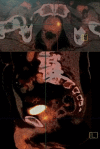Large-cell neuroendocrine tumor of the prostate: a case report and review of the literature
- PMID: 33957979
- PMCID: PMC8103761
- DOI: 10.1186/s13256-021-02830-5
Large-cell neuroendocrine tumor of the prostate: a case report and review of the literature
Abstract
Background: Primitive neuroendocrine prostate neoplasms are rarely reported. This entity comprises carcinoïd tumors and poorly differentiated neuroendocrine tumors, mainly those of the small-cell type. Large-cell-type primitive tumors are exceptional, and only nine cases are reported in the literature. Similar to neuroendocrine tumors of the prostate, large-cell-type primitive tumors may be observed in the context of conventional adenocarcinoma during androgen deprivation therapy or as prostatic metastasis of a distant neuroendocrine tumor, mainly pulmonary neoplasms.
Case presentation: We report a Caucasian case of a mixed prostatic carcinoma, with the largest component being the large-cell neuroendocine carcinoma, in a patient who underwent a total prostatectomy for a localized cancer. Diagnostic, histological, therapeutic and evolutive aspects are reported and discussed.
Conclusions: Large-cell primitive prostate neuroendocrine carcinoma is a rare but aggressive histological entity, which can be associated or not with an adenocarcinomatous component. Mixed forms have a better outcome, mainly when diagnosed at an early stage.
Keywords: Local neoplasm recurrences; Neuroendocrine carcinoma; Prostate neoplasms; Prostatectomy.
Conflict of interest statement
The authors declare that they have no competing interests.
Figures



References
Publication types
MeSH terms
Substances
LinkOut - more resources
Full Text Sources
Other Literature Sources
Medical

